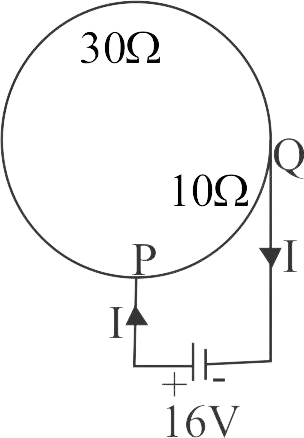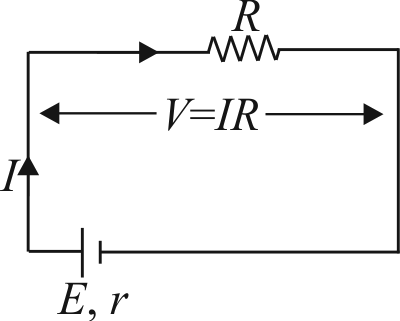356902
A circular coil of radius \(R\) has a resistance of \(40\Omega \). Figure shows two points \(P\) and \(Q\) on the circumference separated by a distance \(\frac{{\pi R}}{2}\), which are connected to a 16\(V\) battery with internal resistance of \(0.5\Omega \). What is the value of current \(I\) flowing through the circuit?
356904 A battery is charged at a potential of \(15\,\;V\) for \(8\,H\) when the current flowing is \(10\,\;A.\) The battery on discharge supplies a current of \(5\;\,A\) for \(15\,H.\) The mean terminal voltage during discharge is \(14\,\;V.\) The 'watt-hour' efficiency of the battery is
356902
A circular coil of radius \(R\) has a resistance of \(40\Omega \). Figure shows two points \(P\) and \(Q\) on the circumference separated by a distance \(\frac{{\pi R}}{2}\), which are connected to a 16\(V\) battery with internal resistance of \(0.5\Omega \). What is the value of current \(I\) flowing through the circuit?
356904 A battery is charged at a potential of \(15\,\;V\) for \(8\,H\) when the current flowing is \(10\,\;A.\) The battery on discharge supplies a current of \(5\;\,A\) for \(15\,H.\) The mean terminal voltage during discharge is \(14\,\;V.\) The 'watt-hour' efficiency of the battery is
356902
A circular coil of radius \(R\) has a resistance of \(40\Omega \). Figure shows two points \(P\) and \(Q\) on the circumference separated by a distance \(\frac{{\pi R}}{2}\), which are connected to a 16\(V\) battery with internal resistance of \(0.5\Omega \). What is the value of current \(I\) flowing through the circuit?
356904 A battery is charged at a potential of \(15\,\;V\) for \(8\,H\) when the current flowing is \(10\,\;A.\) The battery on discharge supplies a current of \(5\;\,A\) for \(15\,H.\) The mean terminal voltage during discharge is \(14\,\;V.\) The 'watt-hour' efficiency of the battery is
356902
A circular coil of radius \(R\) has a resistance of \(40\Omega \). Figure shows two points \(P\) and \(Q\) on the circumference separated by a distance \(\frac{{\pi R}}{2}\), which are connected to a 16\(V\) battery with internal resistance of \(0.5\Omega \). What is the value of current \(I\) flowing through the circuit?
356904 A battery is charged at a potential of \(15\,\;V\) for \(8\,H\) when the current flowing is \(10\,\;A.\) The battery on discharge supplies a current of \(5\;\,A\) for \(15\,H.\) The mean terminal voltage during discharge is \(14\,\;V.\) The 'watt-hour' efficiency of the battery is

